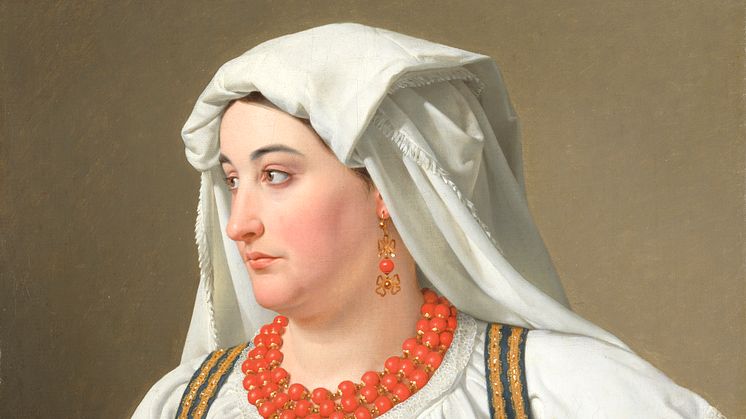
Press release -
New acquisition: Five paintings by Christoffer Wilhelm Eckersberg
Nationalmuseum has added no fewer than five works by Christoffer Wilhelm Eckersberg to its Danish art collection. Each of the works represents a different segment of Eckersberg’s artistic career: from his student years in Paris, via his artistic rebirth in Paris and Rome, to his firmly established but never stagnant later life in Copenhagen.
Christoffer Wilhelm Eckersberg (1783–1853) held a travel scholarship from the Royal Danish Academy of Fine Arts from 1812 to 1816, having already left Copenhagen for Paris in 1810. In Paris, he studied under Jacques-Louis David for about a year. Eckersberg’s art is often viewed in relation to that of his teacher, but in fact he had been in Paris for over a year before beginning his studies with David. Oedipus and Antigone (1812) is an interesting work in this connection. Encountering the artistic treasures of Paris proved an overwhelming experience for Eckersberg, who wrote in a letter home in November 1811 that he was suffering from an inferiority complex. A year later, he reported that he now felt like part of the city’s artistic life.
Could Oedipus and Antigone have played an important part in restoring his self-confidence? The painting must have been one of his greatest challenges up until that point, especially when it came to creating a spatial effect in the composition through the interplay of light with strategically positioned image components. The high standard of the work shows that Eckersberg had reached a degree of maturity and fulfilled much of his potential even before setting foot in David’s studio.
From Paris, Eckersberg’s journey took him to Rome, where he stayed for more than three years before returning to Copenhagen. In Rome, he developed his art further, as can be clearly seen in his famous views of the city and its surroundings. As well as these, he produced a small number of figure paintings, of which Una Ciociara (from Ciociaria, a district near Rome), painted in 1816, was the last. The very high technical standard of this work encapsulates Eckersberg’s development as an artist while in Italy. The creation of this piece was unusually well documented. Eckersberg’s diary tell us that he took great pains in composing his image of the Roman girl. For instance, he rented the model’s costume for two weeks. After his return to Copenhagen, the painting was significant because he used it for teaching purposes and made his students copy it.
Back in Copenhagen, Eckersberg became a professor at the Royal Danish Academy of Fine Arts in 1818. The following year, he received his most prestigious commission to date: painting portraits of King Frederik VI and the royal family. The first part of the job was to paint the king’s portrait in profile. The resulting depiction was adopted as official and reproduced many times by Eckersberg himself and by copyists. Nationalmuseum’s version, dating from 1820, is believed to be the second in Eckersberg’s own series. This version was commissioned by the king as a gift to José Maria O’Neill, an Irish merchant who served as Danish consul general in Lisbon.
In his diary, Eckersberg frequently mentions Rasmus Borch, an art collector who commissioned a number of works, including a portrait of his daughter Karen Margrethe Borch. This portrait is special in various ways: it is almost full-figure, and an illusionistic frame surrounds the motif. There is another similar work by Eckersberg with a painted frame: a nude, now in the Louvre, that was sold by the artist to the same Rasmus Borch. Like the latter work and other nudes by Eckersberg, the portrait features a delicate, classically cool depiction of skin; in other words, the fusion of reality and ideal pursued by Eckersberg throughout his life.
As a professor at the Academy of Fine Arts, Eckersberg occupied an apartment in Charlottenborg Palace in Copenhagen. Nationalmuseum’s recently acquired drawing depicts three of the apartment rooms in series. The image shows that Eckersberg enjoyed tackling scenes with a challenging perspective and also gives us an insight into his artistic life. The walls are hung with paintings in various stages of completion. Other works are resting on the floor, and some are still unframed. On the right-hand wall of the farthest-away room hangs an image that looks like The Cloisters, San Lorenzo Fuori le Mura, which is now at the Art Institute of Chicago. Eckersberg painted this piece in 1824 and sold it that same year, which suggests that the drawing dates from the same period.
These new acquisitions allow Nationalmuseum to tell the story of an unusually long and successful artistic career. The breakthrough that Eckersberg achieved in Denmark during his lifetime is now being repeated internationally, judging by the constant demand for his paintings from museums and collectors worldwide.
The purchase of these works has been made possible by generous donations from the Wiros Fund and the Sophia Giesecke Fund. Nationalmuseum has no budget of its own for new acquisitions, but relies on gifting and financial support from private funds and foundations to enhance its collections of fine art and craft.
Press contacts
Carl-Johan Olsson, Curator: carl-johan.olsson@nationalmuseum.se, +46 8 5195 4324
Hanna Tottmar, Press Officer: press@nationalmuseum.se, +46 767 234632
Categories
Nationalmuseum is Sweden’s premier museum of art and design. The collections comprise older paintings, sculpture, drawings and graphic art, and applied art and design up to the present day. The museum building is currently under renovation and scheduled to open again in 2018. In the meantime, the museum will continue its activities through collaborations both in Sweden and abroad as well as temporary exhibitions at Nationalmuseum Design at Kulturhuset Stadsteatern in Stockholm. Nationalmuseum has partnerships with Svenska Dagbladet and the Grand Hôtel Stockholm, and acknowledges the support of FCB Fältman & Malmén.

